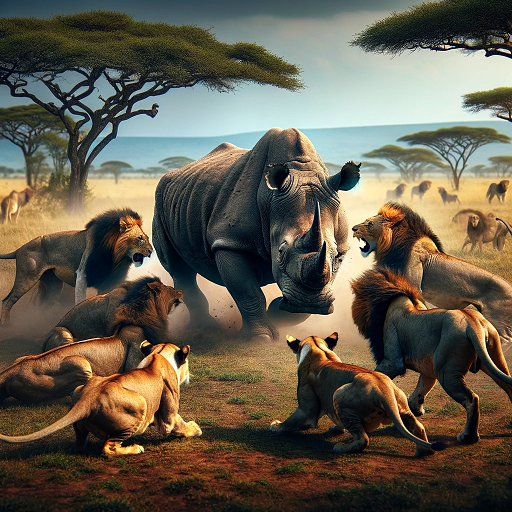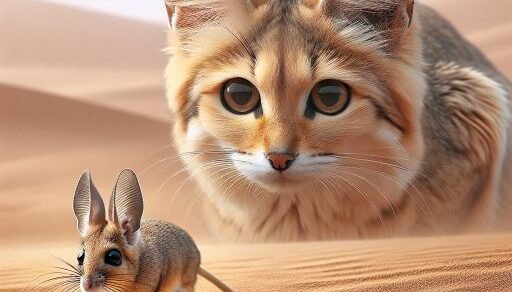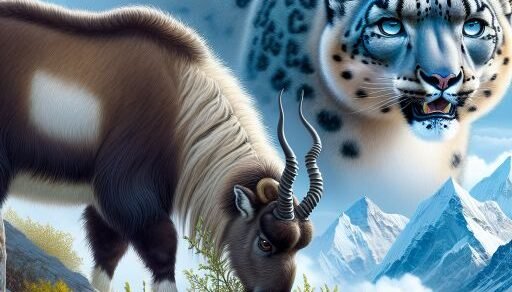Welcome to this exciting wildlife showdown between two of the world’s most impressive animals: the rhinoceros and the polar bear. These two massive creatures are well-known for their impressive size, strength, and formidable defensive and offensive abilities. In this article, we will explore each animal’s strengths and weaknesses in areas such as fighting experience, aggressiveness, speed, endurance, and more. By comparing the characteristics of each animal, we will try to determine who would emerge victorious in a one-on-one fight. So, let’s dive into the world of these powerful animals and see who comes out on top!
Size and Strength
Rhinoceroses are known for their massive size and strength. They can weigh up to 2,000 kg and are equipped with a large horn on their nose, which they use for defense. Polar bears, on the other hand, are also quite large, with males weighing up to 600 kg. However, they do not have the same kind of brute strength as rhinoceroses and rely more on their sharp claws and powerful jaws to take down prey.
Fighting Experience and Technique
Both rhinoceroses and polar bears are skilled fighters but in different ways. Rhinoceroses use their size and horn to intimidate and fend off predators, while polar bears rely on their agility and quick reflexes to outmaneuver their prey. However, rhinoceroses are more used to fighting one-on-one battles, while polar bears are more experienced in hunting and fighting as solitary hunters.
Aggressiveness and Temperament
Both rhinoceroses and polar bears can be quite aggressive when threatened or provoked. Rhinoceroses are known for their short tempers and are quick to charge at anything that they perceive as a threat. Polar bears are also highly aggressive when hunting or defending their territory, and are not afraid to take on animals much larger than themselves.
Speed and Agility
While rhinoceroses are powerful, they are not known for their speed or agility. In contrast, polar bears are incredibly fast and agile, capable of reaching speeds of up to 40 km/h and quickly changing direction. This gives them an advantage in chasing down prey and dodging attacks.
Endurance and Stamina
Both rhinoceroses and polar bears have impressive endurance and stamina, allowing them to fight or hunt for extended periods of time. However, polar bears are better adapted to long-distance travel and can swim for long distances in search of food, whereas rhinoceroses are more suited to short bursts of activity.
Weapons or Defensive Mechanisms
Rhinoceroses have large horns, which they can use to defend themselves from predators or attackers. They also have tough skin and thick muscles, making them difficult to injure. Polar bears have sharp claws and powerful jaws, which they can use to take down prey or defend themselves. They also have thick fur, which helps insulate them from the cold.

Ability to Finish Opponent
Both rhinoceroses and polar bears have the ability to finish off their opponents, but they do so in different ways. Rhinoceroses will often use their horn to impale their enemies, while polar bears will use their jaws to deliver a fatal bite to the neck or head.

What They Normally Prey Onto
Rhinoceroses are herbivores and primarily eat grasses and leaves, while polar bears are carnivores and mainly prey on seals and fish.
What Strategy They Use to Hunt
As solitary hunters, polar bears will typically stalk their prey before pouncing on it, using their speed and agility to get close. They may also wait near a seal’s breathing hole, waiting for the seal to surface before attacking. Rhinoceroses do not actively hunt but will defend themselves if they feel threatened.
Considering This, Who Would Win One-On-One Fight?
While the rhinoceros has the advantage in size and strength, the polar bear’s agility and sharp claws and teeth make it a formidable opponent. However, since polar bears are solitary hunters and not used to fighting large animals one-on-one, it is likely that a rhinoceros would have the upper hand in a fight. Overall, I would give the rhinoceros a 60% chance of winning in a one-on-one fight with a polar bear. However, it is important to remember that in the wild, these animals would not typically fight each other, as they inhabit different environments and have different prey and hunting strategies.

Conservation Status
Rhinoceros: The Vulnerable Giants The rhinoceros, a symbol of wilderness majesty, faces a dire threat from poaching and habitat loss. Their horns, highly coveted in illegal wildlife trade, have placed them at the brink of extinction. The conservation efforts for these ancient creatures are a race against time, with initiatives focusing on anti-poaching patrols and habitat conservation. Currently, several species of rhinoceros are classified as critically endangered, making their survival a key concern for wildlife conservationists.
Polar Bear: The Melting Future Polar bears, the Arctic’s wandering nomads, are confronting a challenge of a different nature – climate change. With the rapid melting of sea ice, their primary habitat is vanishing, posing a significant threat to their survival. Listed as vulnerable, their future is intertwined with the health of the Arctic ecosystem. Conservation efforts are increasingly focusing on climate action, along with protecting their hunting grounds from industrial impacts.
Unveiling the Unknown
Rhinoceros: More Than Just Horns
- Communication Skills: Despite their solitary nature, rhinoceroses have a complex system of vocalizations and markings to communicate.
- Sensitive Souls: Contrary to their tough exterior, rhinos have a sensitive side, with a keen sense of smell and hearing.
- Mud Baths for Health: They often indulge in mud baths, which protect their skin from the sun and insect bites.
Polar Bear: The Arctic’s Ingenious Survivor
- Swimming Prowess: These bears are excellent swimmers, known to cover distances of over 60 miles in icy waters.
- Unique Hunting Techniques: Apart from stalking seal holes, they also use a technique called ‘still-hunting,’ waiting motionless for hours above a seal’s den.
- Caring Mothers: Female polar bears build elaborate snow dens for birthing and nurturing their cubs, showing an unexpectedly tender side.
For a deeper understanding of the polar bear’s hunting abilities and survival strategies in the harsh Arctic environment, don’t miss our detailed exploration in “Polar Bear vs Sea Lion: The Ultimate Arctic Battle”. Similarly, to witness how the formidable rhinoceros matches up against another giant of the wild, the elephant, check out “Rhinoceros vs Elephant: Who Will Come Out on Top?”. These fascinating confrontations shed light on the diverse and complex interactions within the animal kingdom.




